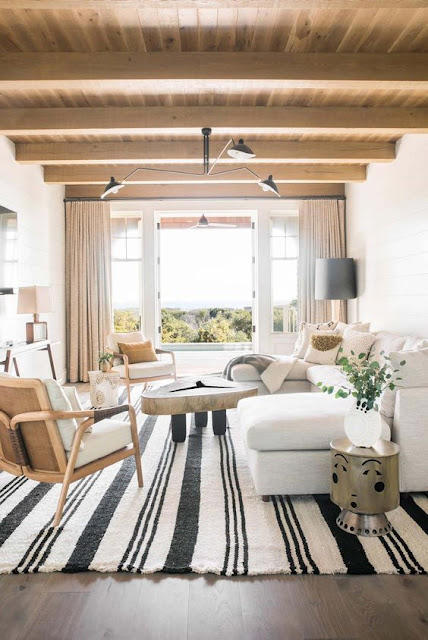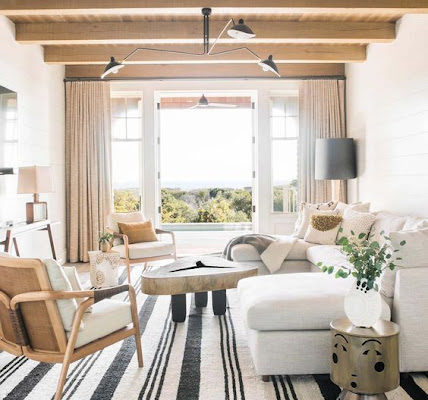What Design Style Are You
joy of nesting
To me, having style means looking classic and timeless. It means observing that function and comfort come first but it also means having the confidence to break a few rules. It’s making
a grand gesture occasionally. It’s playing with scale, line, and balance. It’s
trusting your instincts. And it’s knowing how to combine styles, patterns,
textures and color in appealing ways.
The
term “style” is defined by businessdictionary.com as “elements combined and
expressed in a particular manner”. Having
style, more than anything, is about putting complimentary elements together in
a way that tells your own story.
term “style” is defined by businessdictionary.com as “elements combined and
expressed in a particular manner”. Having
style, more than anything, is about putting complimentary elements together in
a way that tells your own story.
To
understand how style works in the home you first need to understand what works
for you, your architecture, and your geography.
As a good haircut flatters a certain shape of face, the right furnishings
will work with and flatter your home’s overall design. Remember the sixties
television show “Green Acres” with Eddie Albert and Zsa Zsa Gabor? They had a
farmhouse out in the middle of nowhere (Hooterville) filled with “Lisa’s” elaborate
furnishings from her Park Avenue penthouse. It was a decorating faux pas at its
finest, although it seemed to work for Lisa.
understand how style works in the home you first need to understand what works
for you, your architecture, and your geography.
As a good haircut flatters a certain shape of face, the right furnishings
will work with and flatter your home’s overall design. Remember the sixties
television show “Green Acres” with Eddie Albert and Zsa Zsa Gabor? They had a
farmhouse out in the middle of nowhere (Hooterville) filled with “Lisa’s” elaborate
furnishings from her Park Avenue penthouse. It was a decorating faux pas at its
finest, although it seemed to work for Lisa.
Style
as it’s used in architectural terms is classified by a number of things
including historic period, materials, size, roof pitch, as well as other
details like windows and hardware. Many of the newly constructed homes today
are a mix of architectural styles making it almost impossible to clearly
identify them. Asking a half a dozen architects “what style is my home” will
often give you half a dozen answers.
as it’s used in architectural terms is classified by a number of things
including historic period, materials, size, roof pitch, as well as other
details like windows and hardware. Many of the newly constructed homes today
are a mix of architectural styles making it almost impossible to clearly
identify them. Asking a half a dozen architects “what style is my home” will
often give you half a dozen answers.
Common
architectural styles to California are arts and crafts bungalows, sprawling
ranch style homes, ornate Victorian’s, romantic Spanish revivals, seaside
cottages, rustic log cabins, and mid-century modern structures like those you
see in the Hollywood Hills and Palm Springs.
architectural styles to California are arts and crafts bungalows, sprawling
ranch style homes, ornate Victorian’s, romantic Spanish revivals, seaside
cottages, rustic log cabins, and mid-century modern structures like those you
see in the Hollywood Hills and Palm Springs.
In
the furniture industry, style is typically split into two categories:
traditional and contemporary. Somewhere along the way we added an additional
category called transitional which loosely means a mix of both. There are many
sub-categories and various influences within the three basic styles such as
Danish Modern, French Moderne, Mid-Century Modern, Swedish style, the various
Louis’, and more. Off shoots of these styles could loosely be described with
terms such as Romantic/British, Bohemian, Retro/60’s, French/Chic, Town and
Country, and Modern/Polished. I’ll talk about some of these styles today as
well as the power that color has on the overall feel of your home.
the furniture industry, style is typically split into two categories:
traditional and contemporary. Somewhere along the way we added an additional
category called transitional which loosely means a mix of both. There are many
sub-categories and various influences within the three basic styles such as
Danish Modern, French Moderne, Mid-Century Modern, Swedish style, the various
Louis’, and more. Off shoots of these styles could loosely be described with
terms such as Romantic/British, Bohemian, Retro/60’s, French/Chic, Town and
Country, and Modern/Polished. I’ll talk about some of these styles today as
well as the power that color has on the overall feel of your home.
When
I think of “romantic” styled interiors I think of Benison floral linens, rich mahogany
tables, document prints, soft textures, overflowing
flower arrangements, beautiful European and American antiques, polished silver
services, plenty of cushy, upholstered seating, and muted colors. Sometimes tailored
and refined, sometimes busy, this style leans to the feminine side with dark
wood tables and case goods adding masculinity for balance. It is traditional.
I think of “romantic” styled interiors I think of Benison floral linens, rich mahogany
tables, document prints, soft textures, overflowing
flower arrangements, beautiful European and American antiques, polished silver
services, plenty of cushy, upholstered seating, and muted colors. Sometimes tailored
and refined, sometimes busy, this style leans to the feminine side with dark
wood tables and case goods adding masculinity for balance. It is traditional.
Designers
Suzanne Rheinstein (Los Angeles) and Charlotte Moss (New York) create some
lovely examples of this genre. Their rooms are densely furnished with great art and accessories. This type of home décor is meant to evolve
with its inhabitants through items obtained via travel, gifts received and
special purchases made over the years.
It’s meant to grow and change and takes well to additions.
Suzanne Rheinstein (Los Angeles) and Charlotte Moss (New York) create some
lovely examples of this genre. Their rooms are densely furnished with great art and accessories. This type of home décor is meant to evolve
with its inhabitants through items obtained via travel, gifts received and
special purchases made over the years.
It’s meant to grow and change and takes well to additions.
There
are spare home décor styles too. Swedish and Belgian for example, lean toward
neutral color schemes, simple antiques, white washed woods, pale paints and natural
fibers. You’ll see softly worn linens, cottons and wools and the occasional
neutral colored stripe. You won’t see many floral prints, at least not on the
furniture. The furniture has clean lines and simple hardware. Artworks most often
paired with this style are oil portraits and still life paintings. One of the
more iconic pieces of this genre is the Swedish grandfather clock. These are
traditional styles.
are spare home décor styles too. Swedish and Belgian for example, lean toward
neutral color schemes, simple antiques, white washed woods, pale paints and natural
fibers. You’ll see softly worn linens, cottons and wools and the occasional
neutral colored stripe. You won’t see many floral prints, at least not on the
furniture. The furniture has clean lines and simple hardware. Artworks most often
paired with this style are oil portraits and still life paintings. One of the
more iconic pieces of this genre is the Swedish grandfather clock. These are
traditional styles.
Homes
with an eclectic mix of styles are more common than ever. Bohemian looks with
ethnic elements like Moorish mirrors, Indian rugs, Suzani quilt motifs, and
tables and dressers inlaid with bone have gained popularity. These types of
rooms generally have strong multi-color schemes with oxblood red, dark violet,
cobalt blue or mustard yellow. This is a very individualized style and isn’t
easy to produce. It is mostly traditional.
with an eclectic mix of styles are more common than ever. Bohemian looks with
ethnic elements like Moorish mirrors, Indian rugs, Suzani quilt motifs, and
tables and dressers inlaid with bone have gained popularity. These types of
rooms generally have strong multi-color schemes with oxblood red, dark violet,
cobalt blue or mustard yellow. This is a very individualized style and isn’t
easy to produce. It is mostly traditional.
“Retro”
style furnishings obviously go well with mid-century, modern homes. This is a
fascinating, well documented design era mostly from the sixties. Designers such
as Charles and Ray Eames, Aero Saarinen, Mies Van Der Rohe and Le Corbusier
created classic furnishings using materials like polished metals, leather,
plastic, and molded plywood. Today these items are being reproduced by licensed
manufacturers. The originals sell at premium prices. I love seeing them paired
with modern architecture and artworks but my favorite way to use them is in
transitional settings, particularly the Saarinen tables and Mies Van Der Rohe
chairs and settees. These are contemporary styles.
style furnishings obviously go well with mid-century, modern homes. This is a
fascinating, well documented design era mostly from the sixties. Designers such
as Charles and Ray Eames, Aero Saarinen, Mies Van Der Rohe and Le Corbusier
created classic furnishings using materials like polished metals, leather,
plastic, and molded plywood. Today these items are being reproduced by licensed
manufacturers. The originals sell at premium prices. I love seeing them paired
with modern architecture and artworks but my favorite way to use them is in
transitional settings, particularly the Saarinen tables and Mies Van Der Rohe
chairs and settees. These are contemporary styles.
Architects
and developers John Lautner, Richard Neutra and Joseph Eichler created mid-century
modern, post and beam structures. This type of engineering eliminated the need
for heavy support walls. They are easily recognized by their expansive glass
walls, the whole idea being to let the outside in.
and developers John Lautner, Richard Neutra and Joseph Eichler created mid-century
modern, post and beam structures. This type of engineering eliminated the need
for heavy support walls. They are easily recognized by their expansive glass
walls, the whole idea being to let the outside in.
Generally speaking, each style has a ten year bell curve. You can see strong preferences in each generation. But the truth is, the styles that look really dated in ten to fifteen years from now are generally the ones that were not that great to begin with. True style isn’t easy to reproduce. It evolves well and doesn’t date quickly.
Some design trends I see working well for women with chronic pain are Swedish and Belgian styles. Styles with textures and soothing colors, washed linen and cotton, velvets and mohair, floral print accent fabrics and soft, and faded stripes.
Keeping color palates simple and soothing like I do in my Full Strategy Session is key for designing homes for women with chronic pain. I also like to keep colors relatively light and consistent, rather than a lot of contrasts. Colors like soft taupe, pale pink, super light flesh tones, grays, grayed blues and white are all comforting colors. And lastly, a mix of antiques and modern pieces, old and new are great style combinations for a soothing overall style.
Go grab my free download Shiree’s Design and Lifestyle Tips to get you moving forward with your own project!
Live beautifully. Eat beautifully.
Shiree’

